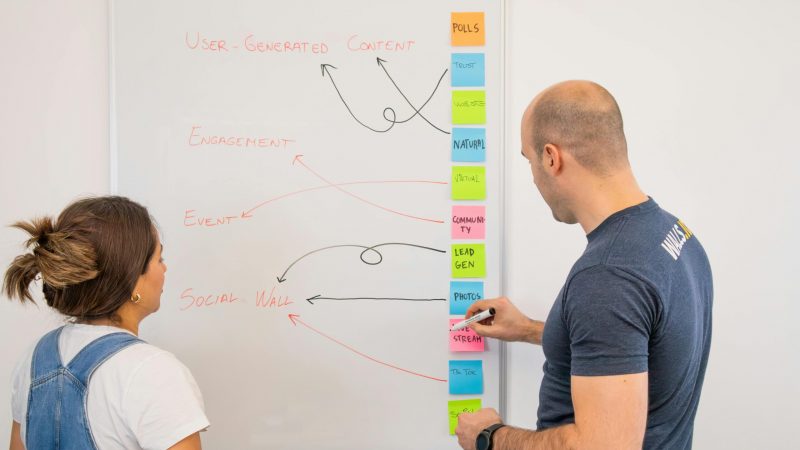Why B2B Content Marketing Strategy Changes Everything
The B2B buying process has dramatically changed. Aggressive sales tactics and cold calls are a thing of the past. Today’s B2B buyers are well-informed and conduct thorough research before contacting sales. This makes your content marketing strategy essential for business growth.
Understanding the Modern B2B Buyer
Consider this: 70% of the buyer’s journey is over before a prospect even speaks to your sales team. This demonstrates how important content is in influencing purchasing decisions. Prospects are actively searching for information, comparing solutions, and developing opinions based on what they find. Your content must grab their attention and build trust and understanding.
The Difference Between B2C Fluff and B2B Substance
B2C content often relies on emotional appeals and instant gratification. B2B content, however, must provide real value and address complex business problems. B2B buyers need data-driven insights and solutions that directly affect their bottom line, not flashy ads. This requires a strategic content creation approach focused on quality over quantity and relevance over reach.
For example, a B2C company might create a short, engaging video about their product’s lifestyle benefits. A B2B company, on the other hand, would create a detailed whitepaper showcasing their solution’s ROI, supported by case studies and data analysis. This difference is key for connecting with a discerning B2B audience.
You might be interested in: How to master the top 7 B2B marketing strategies.
Building Trust and Driving Brand Awareness
B2B content marketing is highly effective at building brand awareness and trust. 83% of B2B marketers report achieving brand awareness goals through content marketing, and 77% report successfully building trust. This is crucial because B2B buyers rely heavily on content when making decisions. By 2025, 49% of B2B buyers say they will rely even more on content to guide their purchases. Find more detailed statistics here: Learn more about B2B marketing statistics.
Turning Challenges into Advantages
B2B marketers face distinct challenges, from long sales cycles and complex buying processes to proving ROI and managing multiple stakeholders. A strong B2B content marketing strategy, however, can transform these challenges into advantages. By offering valuable information, addressing customer pain points, and building trust throughout the buyer’s journey, B2B companies become industry leaders and trusted advisors, ultimately driving measurable business growth. This proactive, customer-focused approach paves the way for long-term success in the competitive B2B world.
Building Your B2B Content Foundation That Actually Works
Stop guessing. A successful B2B content marketing strategy needs a solid foundation. This section outlines the essential framework that separates winning content programs from those just churning out content without a clear purpose.
Defining Your Ideal Customer
First, define your ideal customer profile (ICP). This means figuring out the key traits of companies that will get the most value from what you offer. Things like industry, company size, and revenue are important factors. For example, if you’re selling project management software, your ICP might be mid-sized tech companies with 50-200 employees and over $10 million in annual recurring revenue. A focused ICP helps your content connect with the right audience.
Creating Buyer Personas
Next, create detailed buyer personas. These are semi-fictional profiles that bring your ideal customers to life. Buyer personas provide insights into their motivations, pain points, and how they make decisions. Understanding their needs helps you create content that truly resonates. Imagine your ideal customer is a CMO struggling to manage multiple marketing campaigns. This insight guides your content toward topics like resource allocation and efficient workflow.
Mapping Your Content to the Buyer’s Journey
Mapping your content to the buyer’s journey is crucial. This means understanding the different stages a potential customer goes through, from first learning about you to making the final purchase decision. Then, you need to create content for each stage. Blog posts and videos might attract prospects who are just becoming aware of a problem, while case studies and demos work better for those ready to buy.
Competitive Content Analysis
A competitive content analysis is essential for spotting opportunities. Look at your competitors’ content. What are they doing well? What are they missing? This shows you where you can stand out and offer something unique. For example, if your competitors mainly talk about product features, you can focus on solving customer problems and show thought leadership.
Setting Clear Objectives
Finally, set measurable objectives that support your revenue goals. Your B2B content marketing strategy should have clear targets, like increasing website traffic, generating leads, or boosting sales. This gives your content a purpose and lets you measure how well it’s working. For a deeper dive into B2B SaaS marketing, check out our guide: How to master your B2B SaaS marketing strategy. A solid foundation paves the way for real results.
To further understand the connection between content and the buyer’s journey, consider the following table:
B2B Content Types by Buyer Journey Stage
A comprehensive breakdown of the most effective content formats for each stage of the B2B buyer journey, from awareness to decision.
| Buyer Journey Stage | Primary Goals | Effective Content Types | Success Metrics |
|---|---|---|---|
| Awareness | Generate interest and educate about a problem | Blog posts, infographics, videos, social media posts | Website traffic, social media engagement |
| Consideration | Position your solution and build trust | White papers, ebooks, case studies, webinars | Lead generation, time on site |
| Decision | Encourage purchase and demonstrate value | Product demos, free trials, consultations, testimonials | Conversion rates, sales |
This table demonstrates how specific content types can address the needs and motivations of buyers at each stage. By aligning your content with the buyer’s journey, you can guide prospects towards a purchase decision more effectively. Remember, a successful B2B content strategy isn’t about creating content for content’s sake – it’s about creating content that works.
Creating B2B Content That Actually Converts Prospects
B2B decision-makers consume content differently than the average consumer. Your B2B content marketing strategy needs to address how executives, procurement teams, and technical evaluators process information. These individuals are constantly bombarded with sales pitches. Your content needs to stand out.
Thought Leadership That Builds Authority
Ditch the glorified sales brochures. Authentic thought leadership positions you as an expert by offering real value and perspective. This involves discussing industry challenges, suggesting unique solutions, and initiating productive conversations. Instead of simply highlighting your software’s features, consider creating content that guides CIOs through the complexities of cloud migration. This builds credibility and trust.
Case Studies That Tell Compelling Stories
Case studies are effective tools, but they should be more than just a list of successes. Concentrate on the problems your clients encountered, the solutions you implemented, and the measurable results they achieved. Directly address potential objections and clearly show how your product or service provided solutions to real-world issues. B2B buyers look for proof of your capabilities. This approach delivers it.
Educational Content That Solves Problems
B2B buyers are constantly seeking solutions to their problems. Develop educational resources offering practical advice to help them achieve their business objectives. This could involve blog posts, white papers, webinars, or short videos. For instance, if you sell marketing automation software, create content about improving lead nurturing or streamlining campaign management. This addresses their immediate needs and positions you as a valuable partner. You might be interested in: How to master 10 proven B2B lead generation strategies for SaaS businesses.
Understanding B2B Content Consumption
Understanding B2B content consumption is vital. B2B buyers are busy and often skeptical. They require concise, relevant, and easily digestible information. This means using straightforward language, minimizing jargon, and focusing on value. Consider their preferred formats. Webinars provide in-depth learning, while short videos deliver quick insights.
Choosing High-Performing Content Formats
Some content formats consistently perform well in the B2B arena. Industry studies can generate substantial backlinks and establish thought leadership. Weekly newsletters nurture leads and boost brand awareness. LinkedIn content provides significant organic reach and engages key decision-makers. Experiment with various formats to see what works best for your target audience.
Enhancing Persuasion While Maintaining Authenticity
B2B buyers appreciate authenticity. Your content should be informative and persuasive without being overly promotional. Concentrate on building trust and demonstrating genuine expertise. Offer objective insights, acknowledge limitations, and prioritize customer needs. This approach cultivates lasting relationships. By understanding B2B content consumption and using effective formats, you can develop a content strategy that effectively converts prospects into loyal customers.
Smart Distribution Channels For B2B Content Success
Creating excellent B2B content is only the first step. Without a smart distribution strategy, even the most insightful pieces can fall flat. This section explores the channels where successful B2B companies are connecting with key decision-makers, covering both established platforms and emerging avenues.
Leveraging LinkedIn For Thought Leadership
LinkedIn is the leading social network for B2B, offering significant organic reach and engagement potential. Industry leaders use it to showcase genuine thought leadership, sparking valuable conversations and building strong brand authority. Sharing data-driven insights, original research, and expert commentary positions your company as a valuable resource within your specific niche.
This isn’t about simply reposting blog content. Instead, tailor your message to LinkedIn’s format, actively encouraging interaction and discussion.
Email Marketing For Nurturing Leads
Email marketing remains a powerful tool for nurturing leads throughout the B2B sales cycle, which can often be lengthy and complex. A weekly newsletter is a great way to keep your brand top-of-mind and consistently deliver value to subscribers. This engagement can lead to increased trials and, ultimately, more paying customers.
Avoid generic “sign up for updates” calls to action. Instead, offer a clear and compelling value proposition, such as exclusive content or valuable industry insights. A cybersecurity firm, for instance, could offer a weekly newsletter with the latest threat intelligence and actionable best practices.
Partnering With Industry Publications
Collaborating with respected industry publications significantly extends your content’s reach and boosts its credibility. Contributing guest articles, participating in webinars, or sponsoring research reports can place your company’s message in front of a broader, targeted audience.
This strategy allows you to leverage established readership and solidify your company’s position as a thought leader. Such partnerships also often generate valuable backlinks, strengthening your website’s authority.
Untapped Potential of Account-Based Content Marketing
Account-Based Content Marketing (ABCM) centers on creating highly personalized content tailored to specific, high-value target accounts. By deeply understanding the key stakeholders within these organizations, you can develop content that resonates with their unique needs and challenges.
This targeted approach can dramatically improve both engagement and conversion rates. Instead of a generic whitepaper, for example, create a custom case study demonstrating how your solution addressed a similar issue for a competitor of your target account.
Identifying Where Your Prospects Consume Information
Don’t waste valuable resources on channels your target audience isn’t using. Focus on understanding their preferred information sources. Analyze your website traffic, survey your current customers, and research your competitors’ strategies.
These insights will inform your distribution strategy. Are your prospects active on LinkedIn, or do they prefer engaging in specialized industry forums? Tailoring your approach ensures maximum impact.
Repurposing Content Across Multiple Channels
Maximize your content’s effectiveness by strategically repurposing it for different channels. A webinar can be transformed into a series of blog posts or short, engaging videos. Data-driven insights can be visually represented as an infographic or fuel a dynamic social media campaign.
Maintain consistency to avoid diluting your core message, ensuring each version provides value in its specific format. This repurposing strategy maximizes your efforts without requiring you to constantly create new content from scratch.
Building Meaningful Relationships With Industry Influencers
Partnering with relevant industry influencers can significantly amplify your content’s reach and bolster its credibility. Collaborate on joint ventures, co-create valuable content, or engage in mutually beneficial campaigns.
Prioritize building genuine, long-term relationships based on shared values, rather than short-term transactional exchanges. This authentic approach enhances your brand’s reputation and strengthens your network within the industry.
This comprehensive distribution strategy ensures your valuable B2B content connects with the right people at the optimal time, maximizing its positive impact on your bottom line.
Measuring Real ROI From Your Content Marketing Efforts
Vanity metrics such as page views and social shares offer a glimpse into engagement, but they don’t reveal the complete picture. To truly gauge the effectiveness of your B2B content marketing strategy, you must measure its tangible impact on your business. This means shifting the focus from superficial engagement to metrics that directly correlate with revenue growth.
Beyond Vanity Metrics: Tracking What Truly Matters
Instead of merely counting likes and shares, prioritize measuring how your content contributes to pipeline generation, deal velocity, and customer acquisition costs. These key metrics offer concrete insights into how your content influences your bottom line.
For instance, track the number of leads generated from a specific whitepaper or the degree to which deal closures accelerate after prospects engage with a case study. This strategic shift in focus provides a more precise understanding of your content’s true value.
Attribution Models for Complex B2B Sales Cycles
B2B sales cycles are often intricate and lengthy, involving numerous touchpoints. This complexity makes it challenging to accurately attribute revenue to individual content pieces. However, employing effective attribution models is essential for determining which content truly drives conversions.
Consider using a multi-touch attribution model, which assigns weighted credit to various content pieces encountered by prospects during their buyer journey. This method provides a more comprehensive understanding of content performance and informs data-driven optimization strategies.
Key Performance Indicators (KPIs) That Align With Business Objectives
The KPIs you monitor should align with your specific business objectives. If your aim is to boost brand awareness, concentrate on metrics like website traffic and social media reach. Conversely, if lead generation is your primary goal, focus on metrics like form submissions and demo requests. You might find articles on social media helpful for your B2B content distribution.
Furthermore, tailor your measurement approach to different content formats. The KPIs for a blog post, for example, will differ from those for a webinar or a case study.
Building a Data-Driven Content Strategy
Harness data insights to continuously optimize your B2B content marketing strategy. Analyze which content pieces resonate with your audience and uncover the reasons behind their success. Identify areas for improvement and experiment with different formats and distribution channels to enhance engagement and drive results.
To illustrate how different metrics apply to various business objectives, let’s examine the following table:
B2B Content Marketing KPIs by Business Objective: Essential metrics to track for different B2B content marketing goals, from brand awareness to customer retention
| Business Objective | Primary KPIs | Secondary Metrics | Tracking Tools |
|---|---|---|---|
| Brand Awareness | Website traffic, social media reach, brand mentions | Impressions, share of voice | Google Analytics, social media analytics |
| Lead Generation | Form submissions, demo requests, content downloads | Conversion rates, cost per lead | Marketing automation software, CRM |
| Sales | Revenue generated, deal velocity, customer lifetime value | Average order value, customer churn rate | CRM, sales analytics software |
This table offers a valuable framework for selecting the most relevant metrics for your specific B2B content marketing strategy. By tracking these KPIs, you’ll gain deeper insights into your content’s performance and its impact on your overall business goals.
Implementing Tracking Systems and Dashboards
Investing in robust tracking systems that deliver actionable insights into content performance is crucial. Integrate your analytics platforms with your CRM to achieve a unified perspective of the customer journey. Develop clear, concise dashboards that stakeholders can readily interpret, fostering transparency and enabling data-driven decision-making.
Calculating and Presenting Content Marketing ROI
Mastering the accurate calculation of your content marketing ROI is paramount. This involves diligently tracking costs associated with content creation and distribution, alongside the revenue generated from content-influenced conversions. Construct compelling business cases to justify increased investment in your content marketing endeavors. Clearly showcasing the direct correlation between content and revenue growth is instrumental in securing executive buy-in.
Practical Guidance for Continuous Optimization
These practical guidelines empower you to transcend vanity metrics and prioritize measuring the actual impact of your B2B content marketing initiatives. By implementing these strategies, you can showcase the true value of your content and solidify the rationale for sustained investment.
Scaling Your B2B Content Without Losing Quality
As your B2B content marketing strategy finds success, scaling content creation presents a significant hurdle. This means producing more content without compromising its quality. This section explores practical solutions from companies that have successfully managed this stage of growth.
Building High-Performing Content Teams
A sustainable, high-quality content operation begins with assembling the right people. This requires hiring experienced writers, editors, and content strategists. These individuals should not only understand the nuances of B2B audiences but also possess solid industry expertise.
Clearly defined roles and responsibilities are also important. Like a well-functioning team, every member needs to understand their contribution to the content creation process. This clarity streamlines workflows and boosts efficiency.
Leveraging Technology and Automation
Technology plays a vital role in scaling content production. Content Management Systems (CMS), for instance, streamline workflows and enhance collaboration. HubSpot or Marketo, examples of marketing automation platforms, can automate content distribution and tailor messaging. These tools automate email campaigns and analyze content performance.
However, don’t rely too heavily on automation. The human touch is essential in B2B. While AI tools can assist with content creation, they can’t replace the strategic insights and specific industry knowledge that foster trust and establish credibility.
Creating Scalable Content Processes
Develop clear, repeatable processes for every stage of content – from planning and creation to distribution. This includes using content calendars, defining workflows, and establishing quality control checklists.
A structured approach, much like a blueprint for a building, keeps content production organized. It also maintains quality as your team grows. This ensures a consistent output that meets your standards.
Content Governance and Quality Control
A content governance framework maintains consistency in messaging and brand voice. Style guides, brand guidelines, and clear editorial processes are key elements of this structure.
Equally crucial is a reliable quality control system. This involves several rounds of review and editing. This rigorous process guarantees accuracy, clarity, and adherence to brand standards. These combined efforts cultivate trust and authority.
Team Management For Sustainable Growth
Effective team management becomes essential as your content team expands. Regular feedback, open communication, and professional development opportunities are crucial for fostering a supportive environment.
A well-supported team is a productive team. This approach fosters a positive work environment and equips team members to manage the demands of increased content production. This results in better quality content and increased job satisfaction.
Intelligently Using AI and Emerging Technologies
AI tools hold immense potential for enhancing B2B content operations. They can support keyword research, topic generation, and even the initial drafting of content.
However, strategic use is paramount. These tools should enhance, not replace, human capabilities. Maintaining the human element is essential for ensuring content authenticity and keeping your B2B content marketing strategy aligned with your overall business goals.
By integrating the strengths of your team with smart technology usage and defined processes, you can scale your B2B content creation. This ensures you expand your reach without compromising the quality that drives results.
Key Takeaways
This section covers the most important parts of a successful B2B content marketing strategy, offering practical advice you can use right away. Based on real-world results and proven experience, these key takeaways provide a clear path for sustainable growth.
Essential Strategies for B2B Content Marketing Success
A strong B2B content marketing strategy depends on understanding your audience, creating valuable content, and distributing it effectively. This means going beyond simple metrics like page views and focusing on real business results.
- Know Your Audience: Clearly define your ideal customer profile (ICP) and create detailed buyer personas. This helps you tailor your content to their specific needs and challenges.
- Provide Real Value: Focus on creating content that solves problems, shares expert insights, and builds trust. Avoid overly promotional language and aim to become a go-to resource for your audience.
- Strategic Distribution: Great content needs a smart distribution plan. Use LinkedIn to share thought leadership, email marketing for nurturing leads, and consider partnerships with industry publications for wider reach.
- Measure What Matters: Track key metrics that align with your business goals. These might include pipeline generation, deal velocity, and customer acquisition cost. Data-driven analysis helps refine your strategy and prove its return on investment (ROI).
Warning Signs to Watch For
Even with a well-defined strategy, there are challenges to watch out for. These warning signs can indicate your content marketing strategy needs some changes.
- Lack of Clear Objectives: Content without a clear purpose is unlikely to be effective. Make sure your content strategy supports measurable business goals.
- Ignoring the Buyer’s Journey: Content should be tailored to each stage of the buyer’s journey. Address the specific needs of potential customers at each step, from initial awareness to final decision.
- Over-Reliance on Automation: While automation tools can be helpful for content creation and distribution, remember the importance of the human touch. Building real relationships with a B2B audience requires authenticity.
- Neglecting Content Promotion: Creating quality content is only half the work. Actively promote it through targeted outreach, email marketing, and strategic partnerships.
Success Metrics That Matter
To measure the effectiveness of your B2B content marketing strategy, focus on the metrics that actually drive business growth.
- Pipeline Generation: How much does your content contribute to creating new leads and sales opportunities?
- Deal Velocity: Does your content help speed up the sales process and close deals faster?
- Customer Acquisition Cost (CAC): What’s the impact of your content on the cost of acquiring new customers?
- Customer Lifetime Value (CLTV): Does your content help build strong, long-term customer relationships that lead to repeat business?
Implementation Checklists and Timelines
A successful B2B content marketing strategy needs a structured approach. Here’s a basic checklist to help you get started:
- Define your ICP and buyer personas. (Timeline: 1-2 weeks)
- Analyze your competitors’ content. (Timeline: 1 week)
- Create a content calendar and editorial workflow. (Timeline: 2 weeks)
- Start creating high-quality content tailored to the buyer’s journey. (Timeline: Ongoing)
- Set up tracking systems and reporting dashboards. (Timeline: 1-2 weeks)
- Regularly analyze your results and optimize your strategy. (Timeline: Ongoing)
Building a truly effective B2B content marketing program takes time and consistent effort. While you might see some positive changes within a few months, remember that sustainable results require long-term commitment.
What Separates Successful B2B Content Programs
The most successful B2B content marketing initiatives share some core characteristics:
- Customer-Centric Approach: They focus on providing real value to their audience.
- Data-Driven Decision Making: They use data to guide their strategy and measure its effectiveness.
- Continuous Optimization: They constantly refine their approach based on performance data and changes in the market.
- Long-Term Vision: They understand that building trust and authority takes time, and they’re focused on creating sustainable growth.
Whether you’re building a new program or improving an existing one, these takeaways provide a strong foundation. By focusing on these key principles, you can develop a B2B content marketing strategy that generates real business growth.
Ready to elevate your B2B content marketing? Partner with Northpeak, a Columbus-based b2b growth team, for expert support and data-driven strategies.










